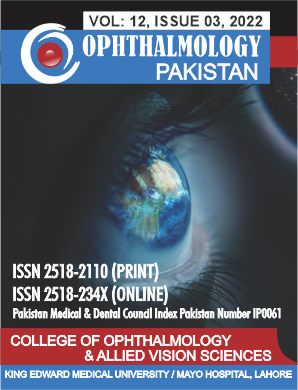Evaluation of reading score in children having different types of amblyopia
Keywords:
Reading score, Amblyopia, MNREAD, ChildrenAbstract
OBJECTIVES: To evaluate reading score words per minute in amblyopic children with the continuous-text reading-acuity test MNREAD.
METHOD: Thirty-one participants with amblyopia (age range from 8-years to 6-years) were included in the study. Visual acuity, stereopsis, fusion, and angle of deviation of all children were assessed. MNREAD chart was used to assess binocular reading speed (wpm) in amblyopic children. Pearson chi-square was used to test the significance of results.
RESULT: Out of 31 children with amblyopia, 58.1% were male. Anisometropic amblyopia was identified in 32.2% while 67.7% had strabismic amblyopia. Participants were further grouped according to the severity of amblyopia i.e., mild amblyopia found in 19.4% participants, moderate amblyopia was present in 35.5% while 45.2% had severe amblyopia. Most of the participants (87.1%) had no stereopsis. More than half of the participants (54.8%) had manifest deviation, 19.4% had latent, while 25.8% were orthophoric respectively. Suppression in amblyopic eye was noted at 33cm and 6m in 41.9% and 61.3% participants respectively. The minimum recorded reading speed was 24.00 wpm while maximum recorded reading speed was 88.00 wpm. A significant correlation (p=0.014) was found between severity of amblyopia and reading score (wpm). There was no correlation found between angle of deviation and reading score (wpm) (p=0.247) while there was a high significant correlation found between type of amblyopia and reading score (wpm) (p<0.01).
CONCLUSION: Reading score (wpm) in amblyopic children was moderately negatively correlated with the severity of amblyopia and type of amblyopia. Strabismic amblyopic children read more slowly as compared to anisometropic amblyopic children. Children with severe form of amblyopia had lower reading speed as compared to moderate and mild type amblyopic children.
KEY WORDS: Reading score, Amblyopia, MNREAD, Children






